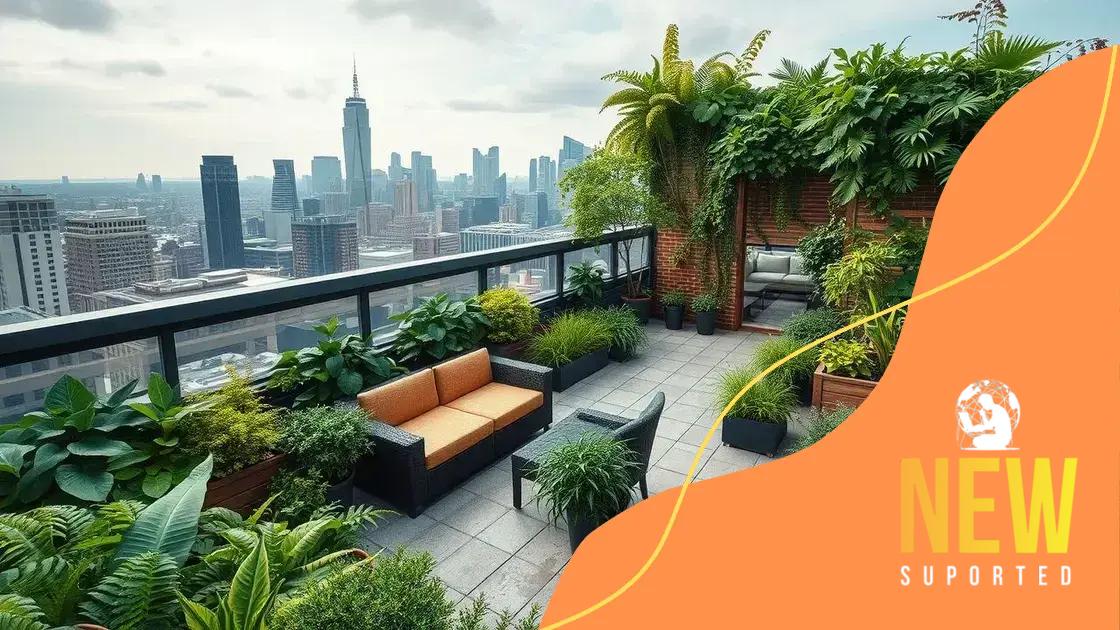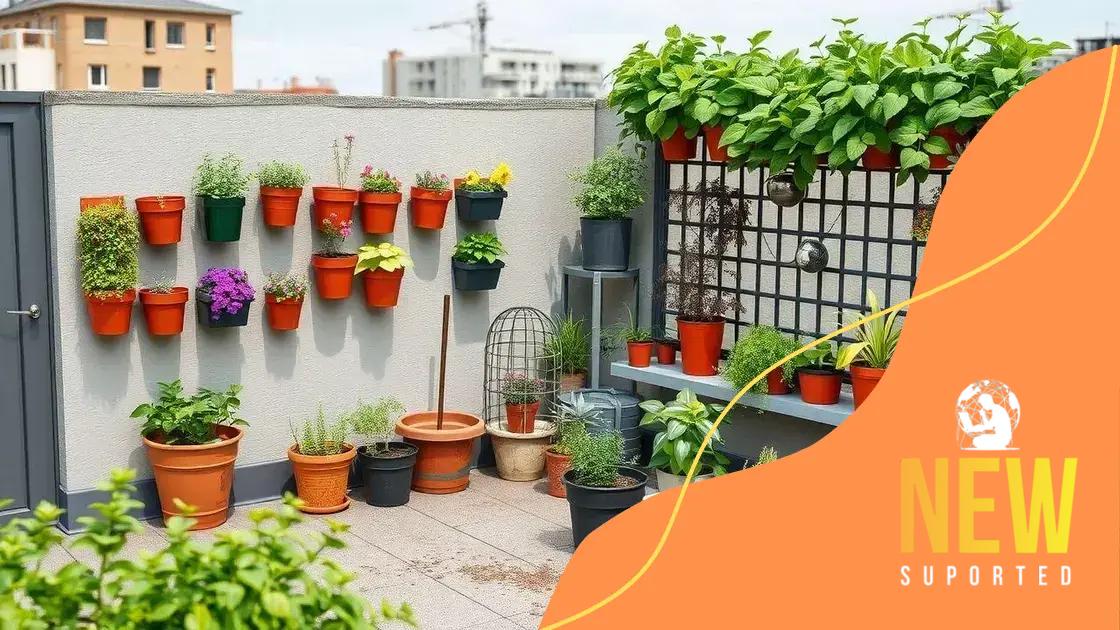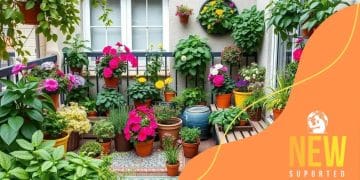How to set up a rooftop garden in the city

To set up a rooftop garden in the city, select suitable plants, establish an efficient watering system, maximize space with vertical gardening, and incorporate comfortable furniture and lighting for an inviting atmosphere.
How to set up a rooftop garden in the city can turn urban living into a greener experience. Have you ever thought about the benefits of cultivating your own plants up high? Let’s dive into the world of rooftop gardening!
Choosing the right plants for your rooftop garden
Choosing the right plants for your rooftop garden is crucial for the success of your green space. You want to ensure that the plants not only thrive but also add beauty and functionality to your area. Consider the amount of sunlight your rooftop receives and the wind conditions. A well-thought-out selection can lead to a vibrant rooftop haven.
Factors to Consider
When picking plants, think about the following:
- Sunlight: Determine whether your rooftop is mostly sunny or partially shaded.
- Wind Exposure: Strong winds can damage delicate plants; choose hardy varieties.
- Weight Limitations: Consider the structural limits of your rooftop. Lightweight plants or containers may be necessary.
- Maintenance: Some plants require more care than others. Select varieties that suit your level of commitment.
Once you address these factors, you can explore various plant options. For a sunny rooftop, consider succulents, herbs, or flowering plants like marigolds. In contrast, for shadier spots, opt for ferns, hostas, or shade-tolerant herbs. Always think about the aesthetics as well; a combination of textures and colors can create a visually pleasing environment.
Recommended Plants
Here are some popular choices:
- Herbs: Basil, thyme, and parsley not only enhance your meals but are easy to grow.
- Succulents: Varieties like jade or aloe require minimal water and thrive in full sun.
- Perennials: Plants like daylilies and lavender return year after year, adding color with little effort.
- Vegetables: Tomatoes and peppers can flourish in pots, giving you fresh produce right from your rooftop.
Ultimately, the right plants can transform your rooftop garden into a lush escape. By paying attention to your rooftop’s specific environment, you can create a thriving oasis that enhances your urban lifestyle. Be sure to regularly check on your plants to ensure they are healthy and flourishing, adapting as needed to ensure the best results.
Essential tools and materials you’ll need
To create the perfect rooftop garden, having the right tools and materials is essential. You want to ensure you are well-equipped to cultivate your green space successfully. Investing in quality tools will make your gardening experience both enjoyable and productive.
Basic Tools
Here are some must-have tools for your rooftop gardening:
- Hand trowel: This handy tool helps you dig, plant, and move soil or plants with ease.
- Pruning shears: Keep your plants healthy by trimming back overgrown branches and dead leaves.
- Watering can: A good watering can is vital for providing delicate plants with the right amount of moisture.
- Gloves: Protect your hands while working in the dirt to avoid cuts and blisters.
Each of these tools plays a crucial role in maintaining your garden, allowing you to work efficiently. It’s important to clean your tools regularly to prolong their lifespan and effectiveness.
Materials You’ll Need
In addition to tools, certain materials are necessary for successful gardening. Think about the following:
- Quality soil: Invest in high-quality potting soil that provides nutrients your plants need.
- Fertilizers: Regular feeding with appropriate fertilizers supports healthy growth.
- Pots and containers: Select pots that suit your plants’ sizes and are designed for proper drainage.
- Mulch: Using mulch helps retain moisture and prevents weeds from taking over.
Choosing the right materials can greatly impact the productivity and health of your rooftop garden. For instance, good drainage is vital for preventing root rot in containers. Consider using self-watering pots to manage moisture levels better. As you gather these essentials, remember that investing in the right tools and materials will lead to a thriving rooftop garden filled with abundant plants.
Tips for maximizing small spaces

Maximizing small spaces in your rooftop garden can be a fun challenge. With some creativity and smart planning, you can grow a variety of plants even in limited areas. Understanding how to use vertical space and choose the right containers is key to creating a thriving garden.
Use Vertical Gardening Techniques
Vertical gardening allows you to make the most of your limited space. Consider the following:
- Wall planters: These are perfect for herbs and small flowers and can be hung easily.
- Planter shelves: Use shelves to add layers of plants, keeping your garden organized and visually appealing.
- Trellises and arches: Climbing plants like peas or beans can be trained to grow upward, saving space.
- Hanging pots: Utilize the space above your head by hanging pots from the ceiling or railing.
With vertical techniques, you can create a lush environment without taking up much ground space. It’s a clever way to add depth and interest to your garden.
Choose Space-Saving Containers
When space is limited, selecting the right containers becomes crucial. Look for:
- Self-watering pots: These can help manage moisture and reduce maintenance.
- Nesting containers: These allow you to stack pots when not in use, saving space.
- Rail planters: Designed to fit on railings, these are great for growing herbs or flowers.
- Vertical planters: These feature multiple levels for planting different varieties in one unit.
By choosing intelligent container designs, you can easily incorporate numerous plants into your small garden setup. Grouping plants with similar light and water requirements can also enhance efficiency.
Finally, don’t underestimate the power of companion planting. Grouping compatible plants can maximize space while improving health and yield. With these tips, your small rooftop garden can flourish beautifully, providing you with fresh produce and a peaceful retreat.
Establishing a watering system
Establishing a watering system in your rooftop garden is essential for keeping your plants healthy. A consistent moisture level is key for growth, especially in containers where soil can dry out quickly. The right watering method can save time and ensure your plants thrive.
Types of Watering Systems
Consider using one of these systems to simplify your watering routine:
- Drip irrigation: This method delivers water directly to the plant’s roots, minimizing waste and reducing evaporation.
- Soaker hoses: These hoses allow water to seep out slowly, providing consistent moisture to the garden beds.
- Self-watering pots: These containers have a reservoir that allows plants to draw water as needed, perfect for busy gardeners.
- Manual watering: For smaller gardens, a watering can or hose with a spray nozzle may be sufficient.
Each of these options can work well, depending on the size and layout of your rooftop garden. It’s important to choose a system that fits your gardening style and the specific needs of your plants.
Watering Schedule
Creating a consistent watering schedule is just as important as the watering system itself. Here are some tips for developing a routine:
- Monitor soil moisture: Regularly check soil moisture levels to determine if watering is needed.
- Water early or late: Watering in the early morning or late afternoon reduces evaporation and helps keep plants healthy.
- Adjust for seasons: Plants may need more water in hot months and less in cooler months.
- Group plants wisely: Place plants with similar watering needs together to simplify care.
By establishing a consistent watering system, you can ensure that your rooftop garden remains vibrant and flourishing. Automating as much as possible will free up your time while giving your plants the attention they need to thrive. Be attentive to individual plant requirements, as some may need more or less water depending on their species and location.
Design ideas to enhance your rooftop garden
Designing your rooftop garden can be an exciting process. Thoughtful design ideas can transform a simple space into a stunning oasis. By incorporating various elements, you can create a visually appealing and functional garden that enhances your urban lifestyle.
Incorporating Different Plant Heights
Using plants of varying heights adds dimension to your garden. Consider the following:
- Tall plants: Use tall grasses or sunflowers at the back or center of your garden beds to create a focal point.
- Midsize plants: Incorporate medium-height flowers like coneflowers or dahlias to frame the taller plants.
- Low-growing plants: Use ground cover plants like creeping thyme or sedum at the front for visual appeal and to prevent weeds.
- Hanging plants: Consider hanging baskets with trailing plants to add vertical interest without taking up ground space.
By blending different heights, you create a layered effect that is both attractive and engaging, making your rooftop garden feel more dynamic.
Utilizing Garden Furniture
Adding furniture can turn your rooftop into a relaxing retreat. Here are some ideas:
- Seating options: Comfortable chairs or a small bench encourage relaxation and enjoyment of your garden.
- Tables: A small table is perfect for morning coffee or evening gatherings.
- Shade structures: Consider adding a shade umbrella or pergola for comfort on sunny days.
- Decorative elements: Use pots, sculptures, or outdoor rugs to enhance your garden’s personality.
Furniture allows you to fully enjoy your rooftop garden by creating functional spaces for socializing or solitude.
Lighting for Ambiance
Proper lighting makes your garden usable at night and creates a warm atmosphere. You might use:
- String lights: Hang fairy lights or lanterns to create a whimsical feel.
- Solar lights: Install solar-powered path lights to illuminate walkways without extra energy use.
- Spotlights: Use spotlights to highlight specific plants or features.
- Candle lanterns: Add candle lanterns for a cozy, romantic ambiance.
With thoughtful design elements, you can enhance your rooftop garden to reflect your personal style while maximizing its potential. Embrace creativity and enjoy the journey of creating a beautiful space that complements your lifestyle.
FAQ – Frequently Asked Questions about Rooftop Gardening
What plants are best for a rooftop garden?
Herbs, succulents, and small flowering plants are great choices for rooftop gardens since they thrive in containers and require less space.
How often should I water my rooftop garden?
Watering frequency depends on plant types and weather conditions. Generally, check soil moisture and water when the top inch of soil is dry.
Can I use regular soil for my pots?
It’s better to use high-quality potting soil, as it provides better drainage and nutrients for container plants.
What furniture is suitable for a rooftop garden?
Opt for lightweight, weather-resistant furniture like aluminum or wicker that can handle outdoor conditions.






